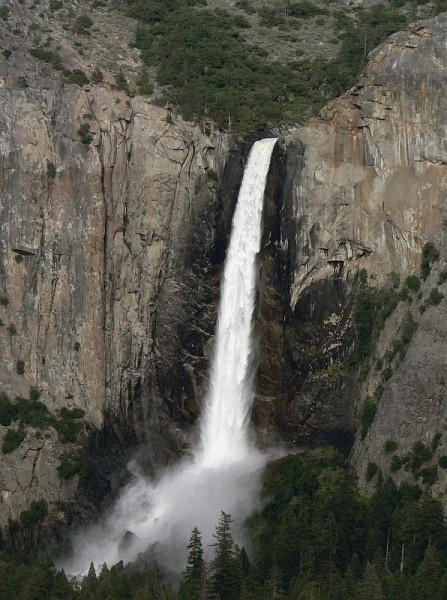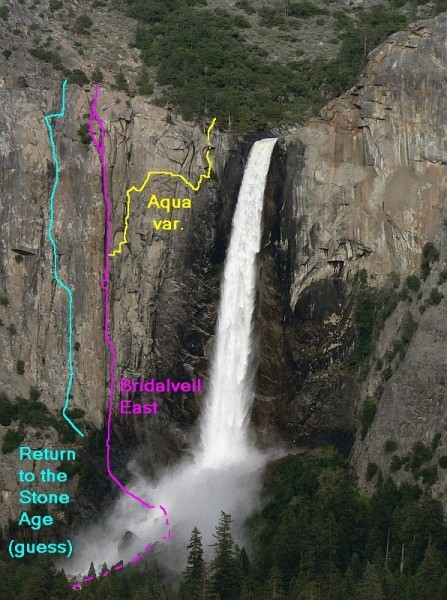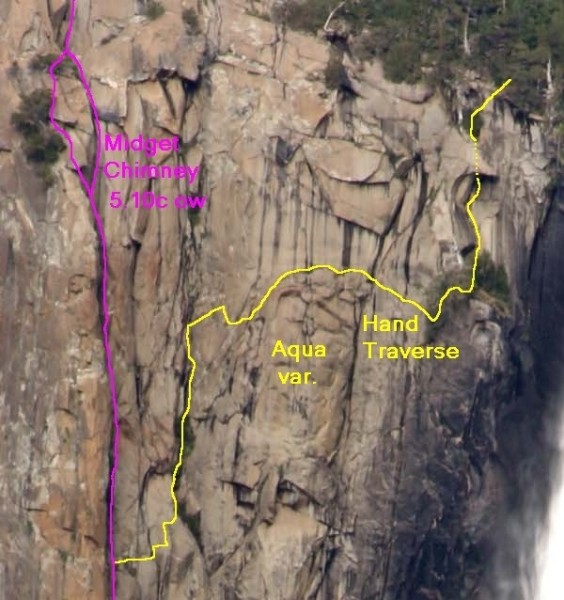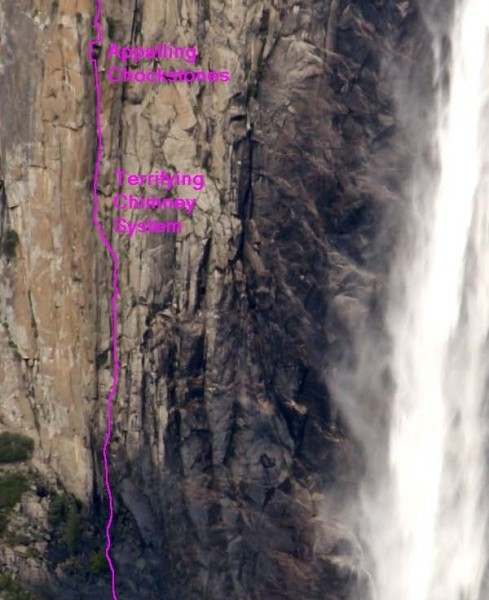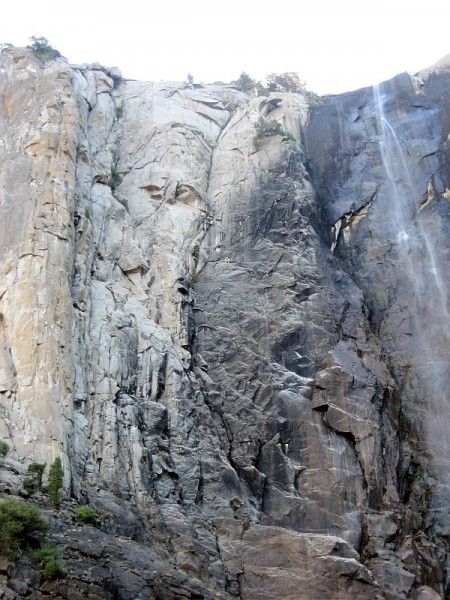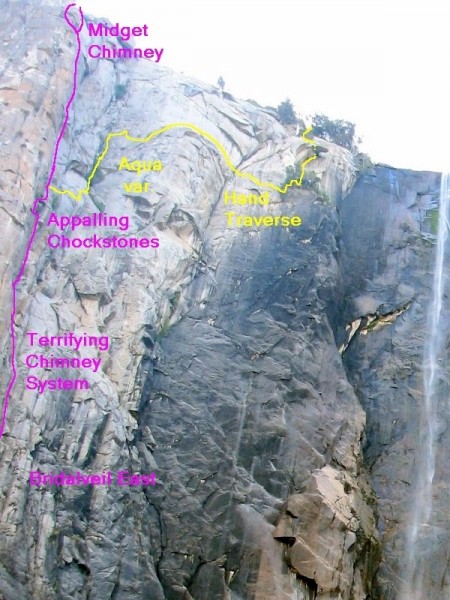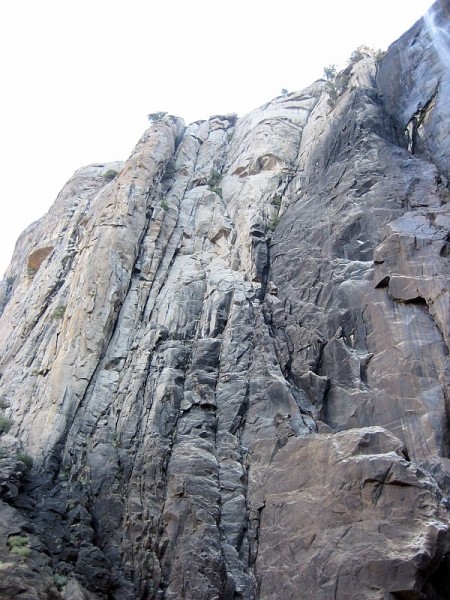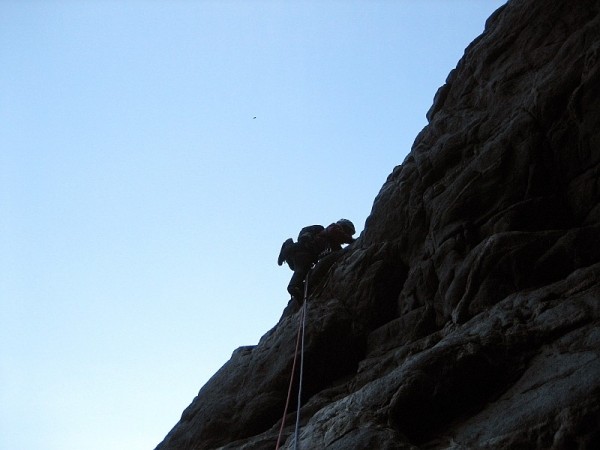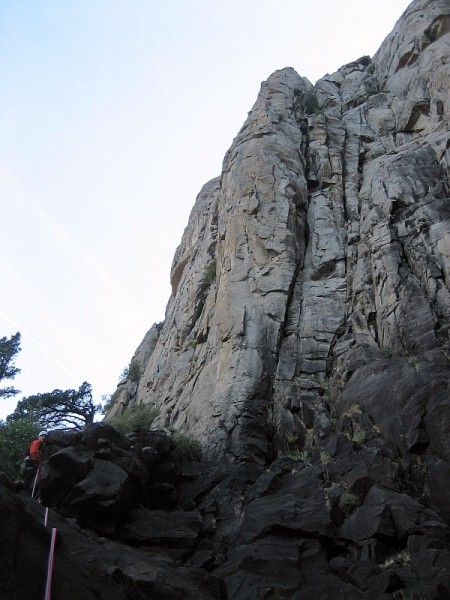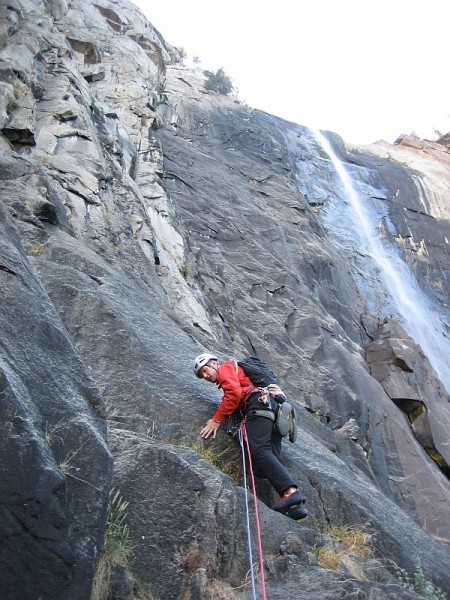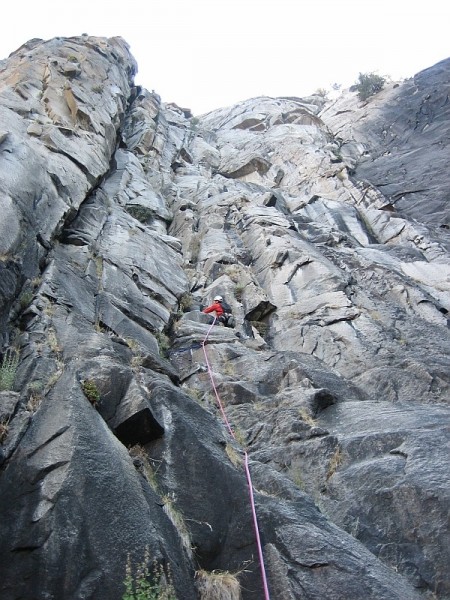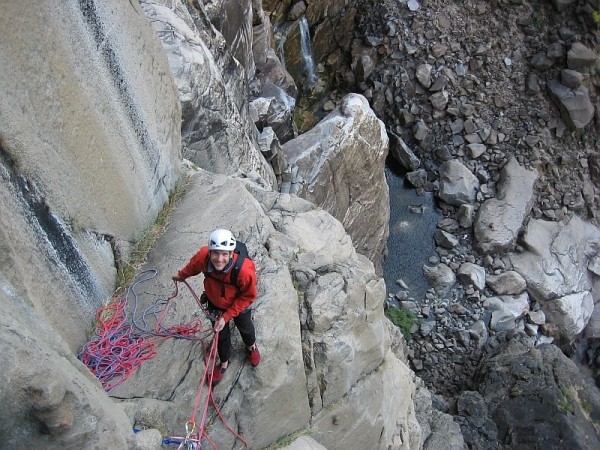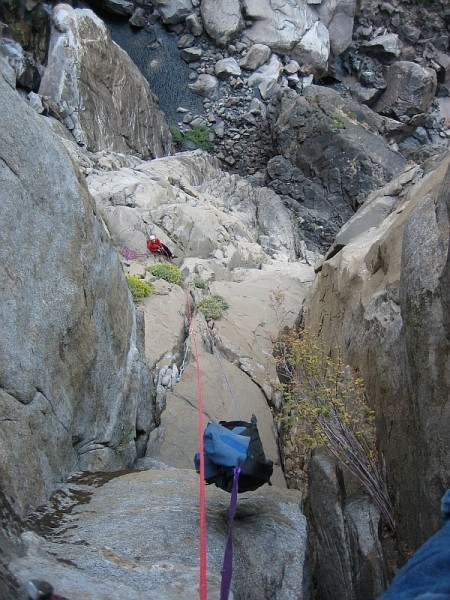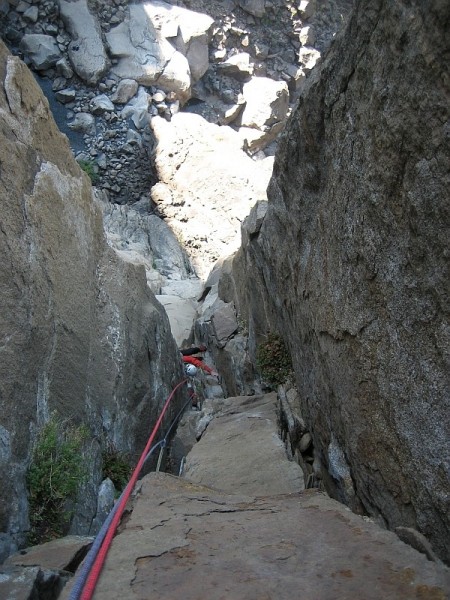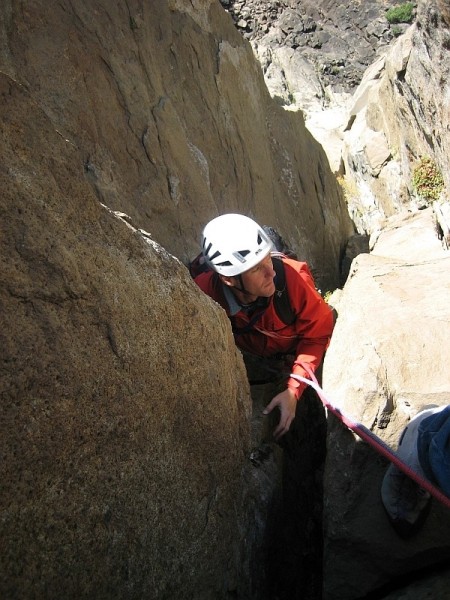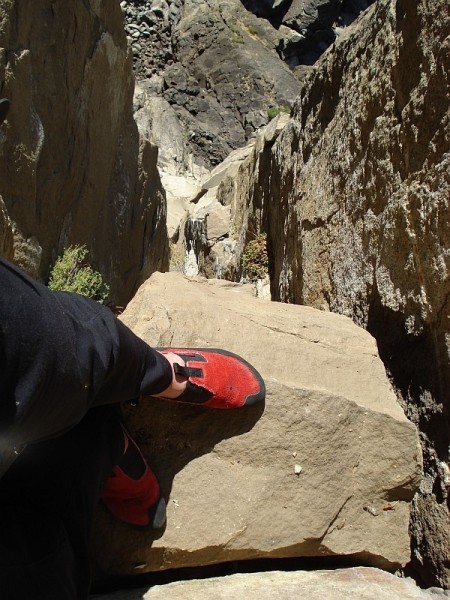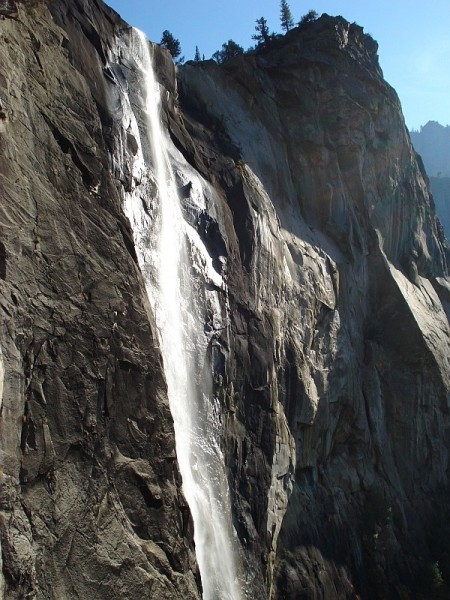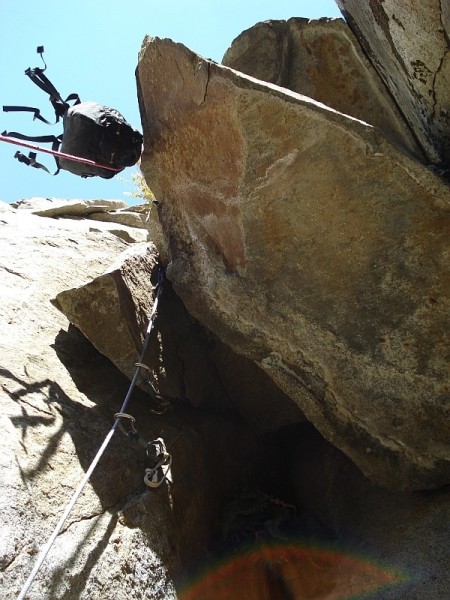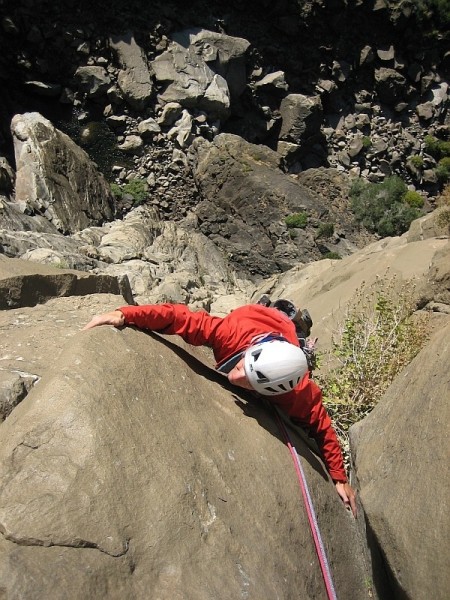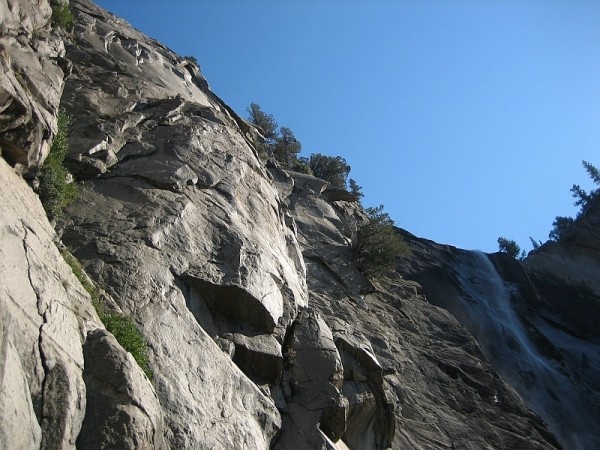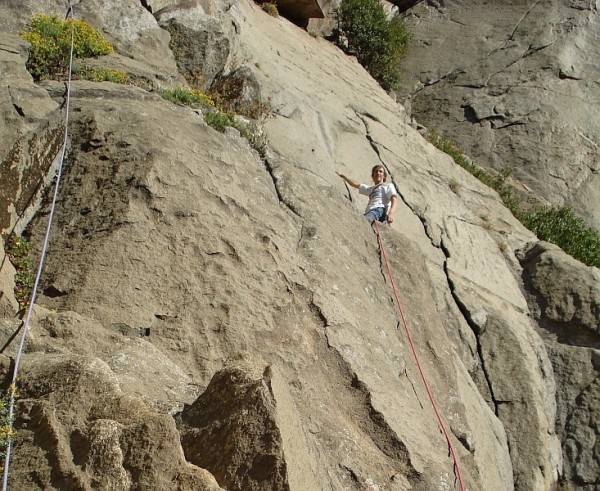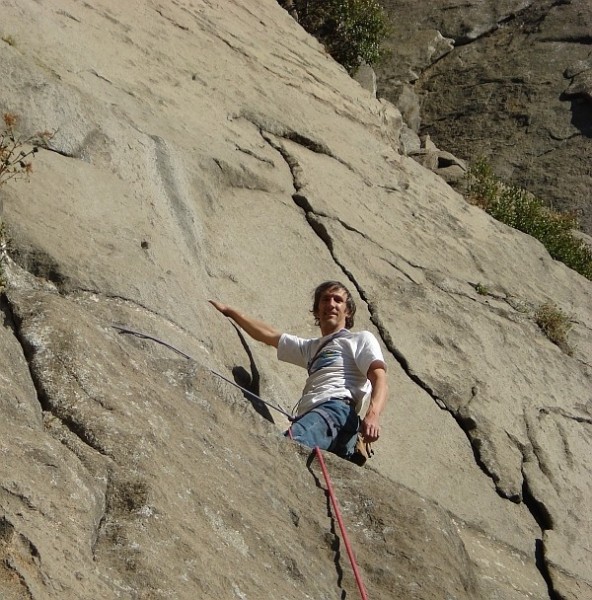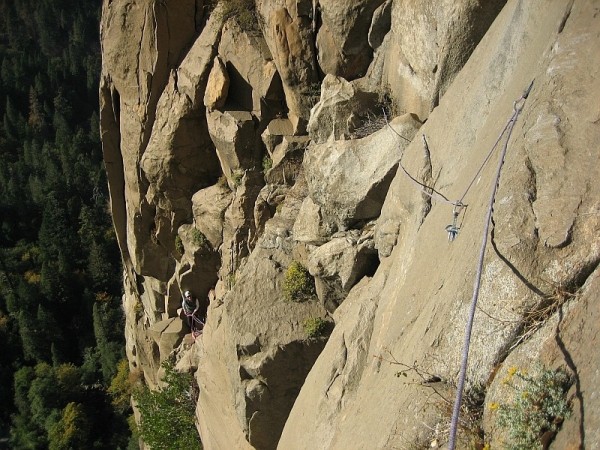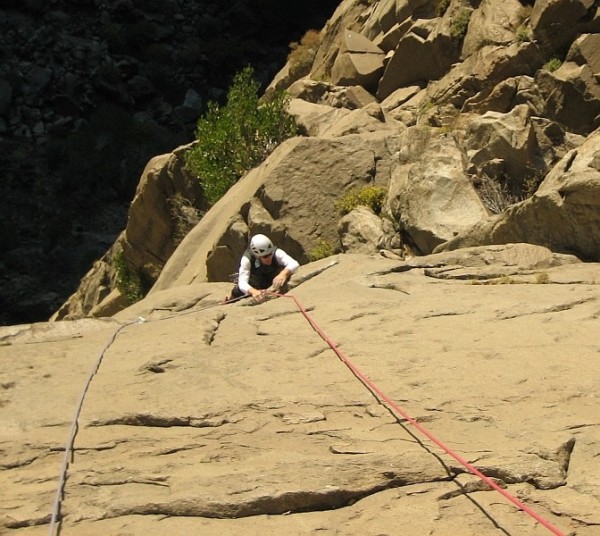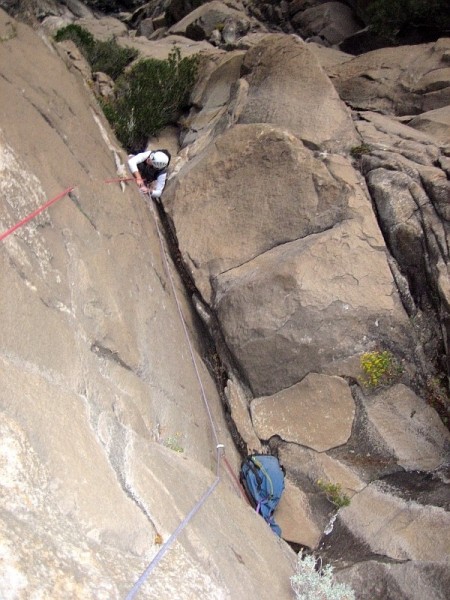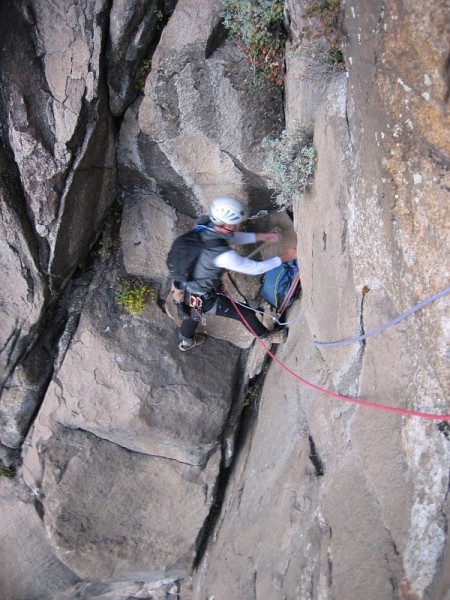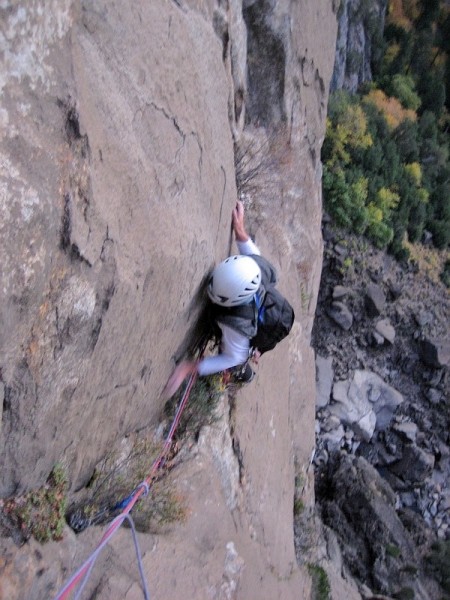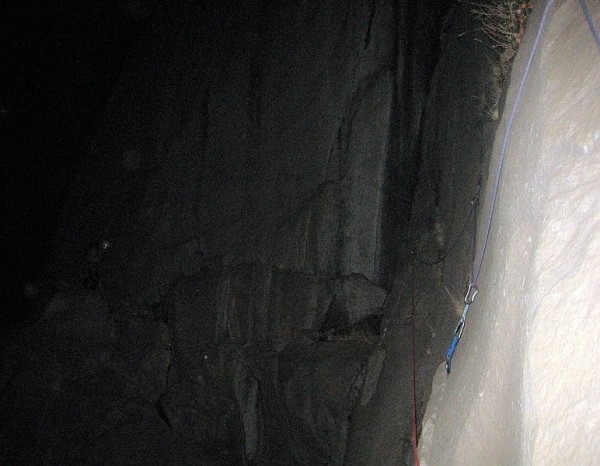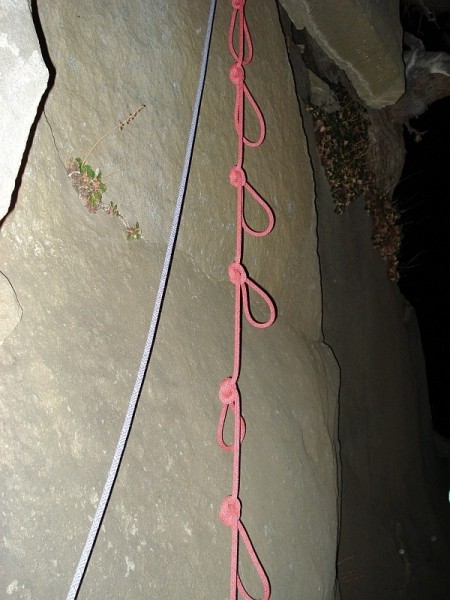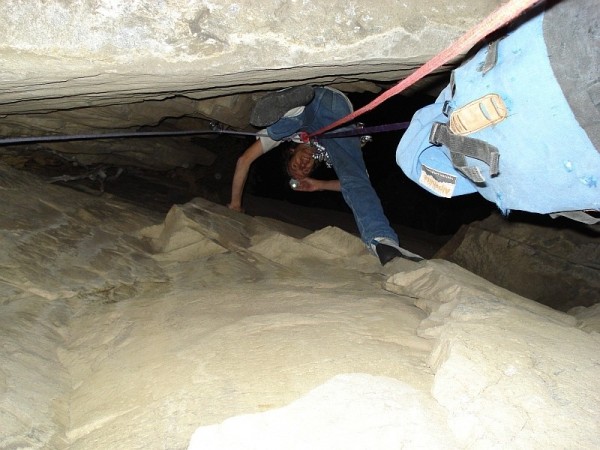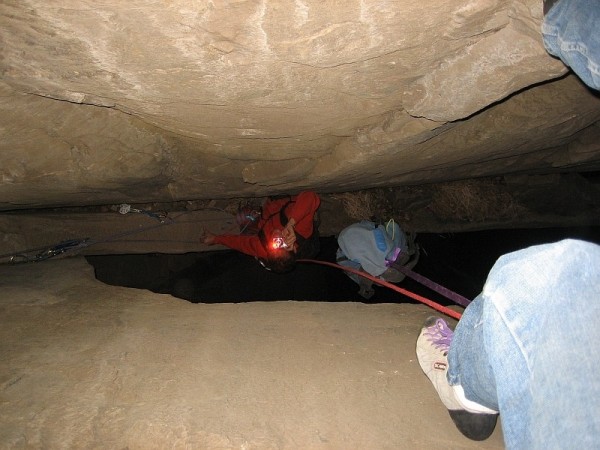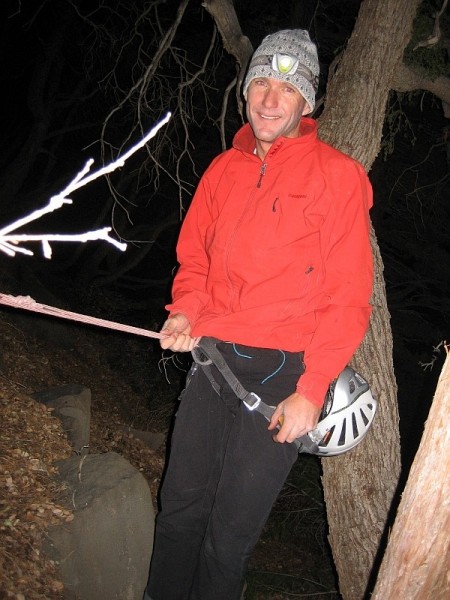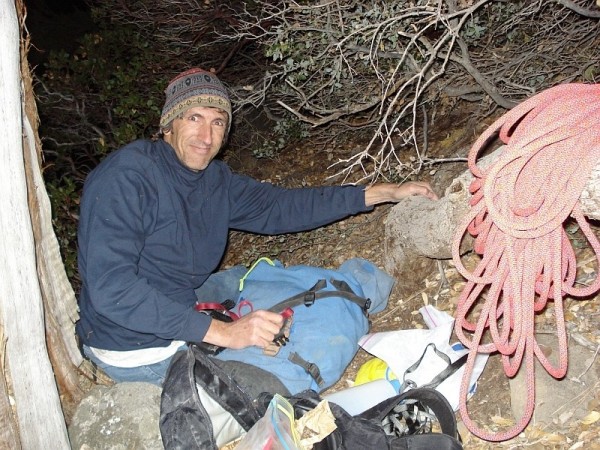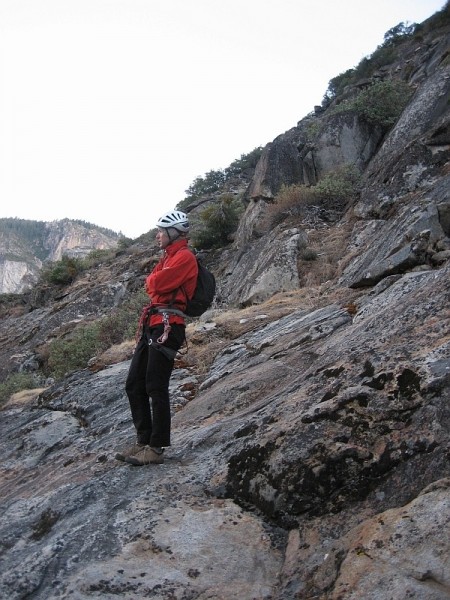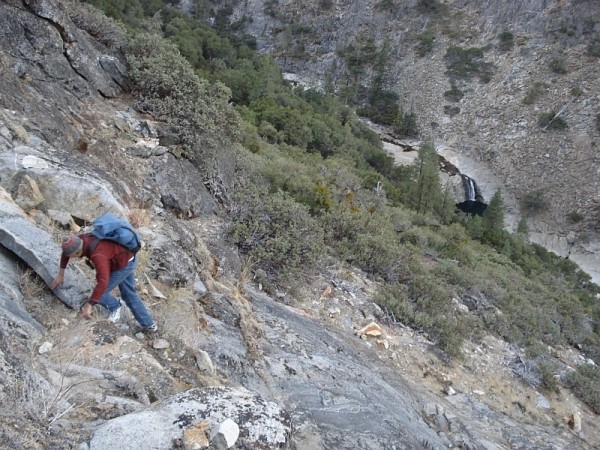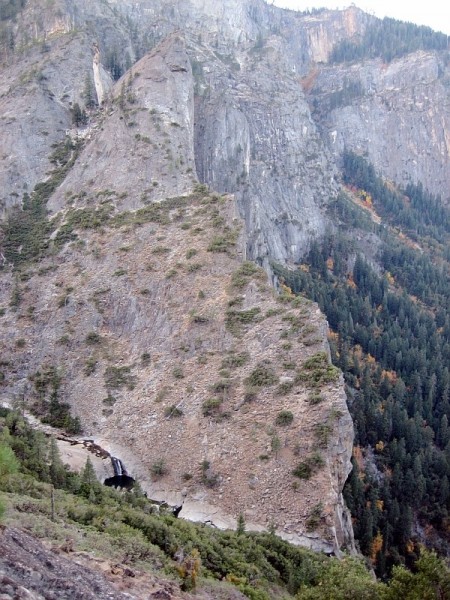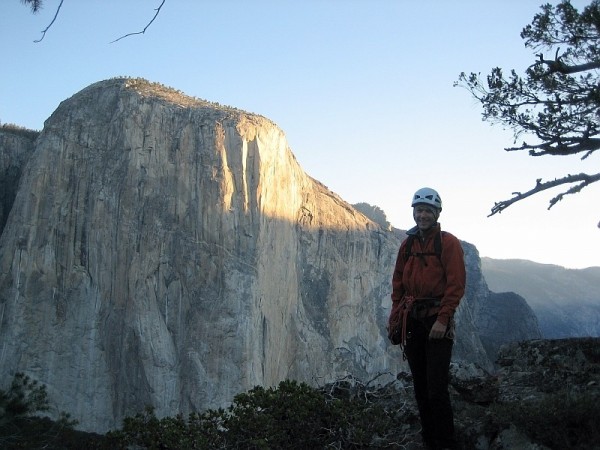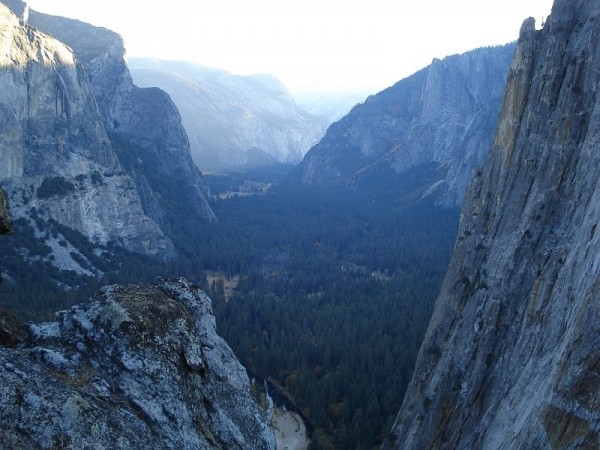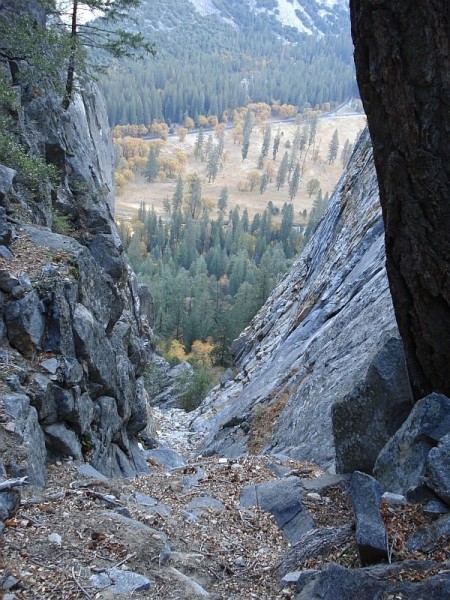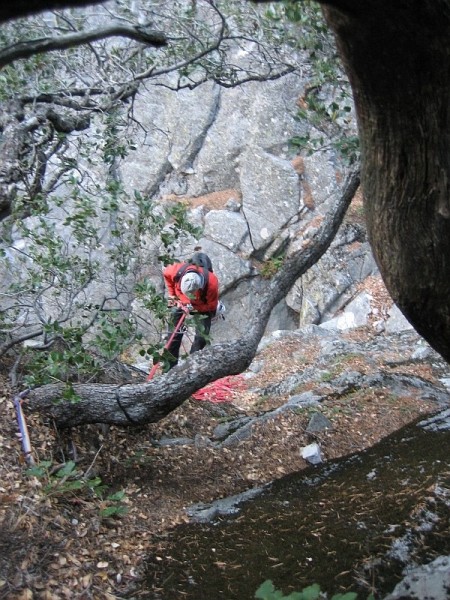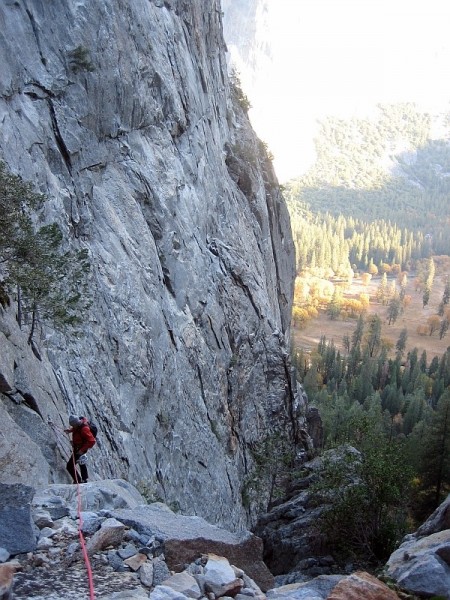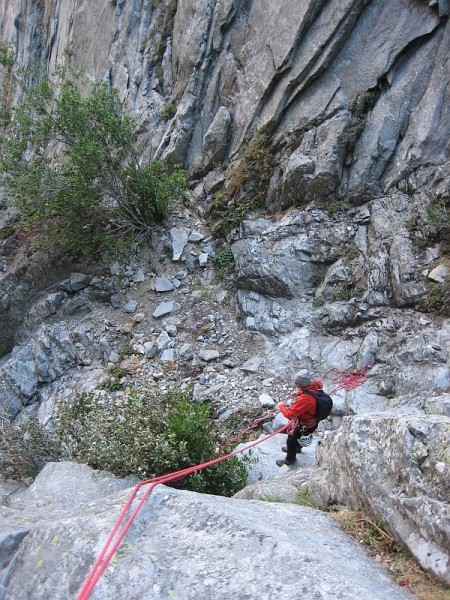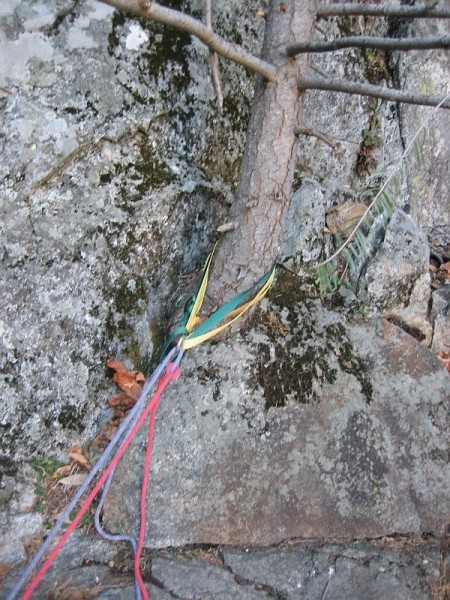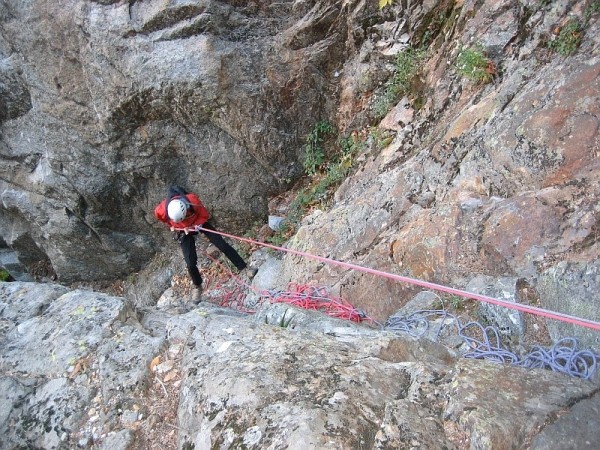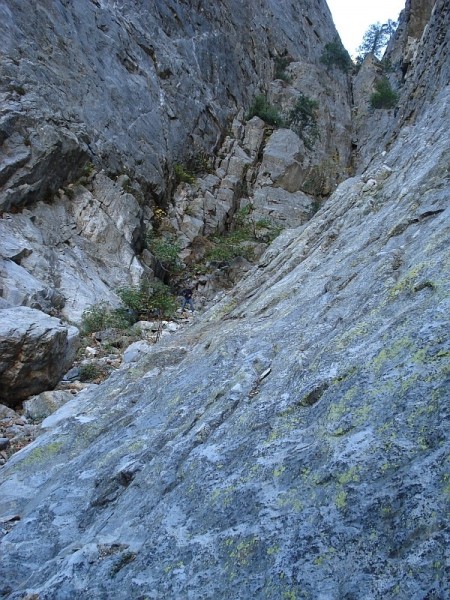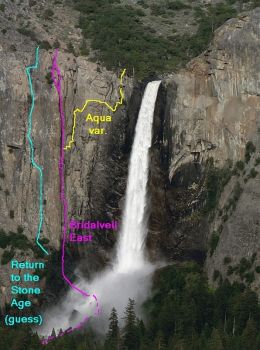I'd been wanting to try this climb, ever since Peter Haan described it as a cool old 5.8 to do in low/no water.
The climb is pretty committing, and is only in the old Roper guidebooks. Retreat after the traverses would involve climbing back across the traverses, leaving gear and rappelling back to Bridalveil East and down it.
Bridalveil Falls - don't try the climbs here when the falls are running this much, unless you want to get very wet and cold.
Try in August/September/October.
Verbal descriptions from the 1964 Roper guide.
view from the paved Bridalveil trail
view from near base of the falls, after approaching up the creek bed
The "prominent and terrifying chimney system" is obvious to the left, just right of the brown buttress.
Bridalveil East climbs this chimney system, except for the first pitch, which takes cracks 20' to the right.
The chimney system is 200' NE of the falls.
pool at the base
We roped up for the "3rd class" approach pitch, which was exposed at first, but then eased quickly.
top of the 3rd class approach pitch
Ken leading p1
crack system 20' right of main chimney system
rated 5.5 on the topo, but it's more like 5.7
Ken ran short on gear, so he built an anchor and I finished the 140' p1
Ken follows the second half of p1
belaying p2 at ledge with rap slings.
p2 starts up a short chimney on the left with a slung chockstone,
face climbs its left wall on jugs, then diagonals left to the main chimney system
It is rated "5.9 fist" on the topo, but is really only 5.7
into the chimney on p2 - I'm dangling my pack
Ken follows the p2 chimney.
reaching the belay stance below the "appalling chockstones".
Unfortunately the belay anchor cams and nuts are not very good, with some loose rock on the right side.
It would be better to continue another 30' to belay on top of the chockstones, or belay 40' lower.
Ken's shoes on the belay stance
There was a little water coming over the falls
p3: hauling packs past the "appalling chockstones" (5.8).
There is an old fixed pin below the chockstones, then good cams.
Ken follows after cranking past the chockstones
View of Aqua variation pitches above.
p4 goes up 20', then traverses right 20' on the brown slab to a
lieback crack in the slab. 10' up the lieback, then right to the bushy "gully".
p5 goes up a steep 5.8 corner handcrack for 50' above the highest tree, then
diagonals up right 20' to a crack, down a little, then right and up a corner to the left end of a big ledge.
p6 walks to the right end of the big ledge, then an easy high hand traverse to the big corner.
A descending 5.6 traverse on the right wall reaches a 1" crack,
then a further descending traverse reaches the lowest big tree, 40' left of the falls.
p4: Starting the 5.8 traverse. There is a long reach to the first positive hold.
The lieback flake is just behind me
Looking back after doing the lieback and traverse to the gully on a sloping rail
Ken on the big handhold at the start of the traverse
p5 squeezes past the highest tree and up a steep 5.8 hand crack corner
Ken follows the corner; there is a lower angle fist move next
Ken about to leave the corner; I made a short lunge for the positive black hold under the red rope
I stopped halfway up p5 to belay Ken as he led some descending moves to the corner on the right.
Ken leads up the corner to the left end of a big ledge;
Rattlesnake Buttress and Leaning Tower behind.
Daylight is fading for us.
p6 - the long traverse. Ken is following left of center, with a slight reflection off his helmet.
He is about to start the high hand traverse to the big corner.
Visible in the flash on the right side is the protection for the downward traverse.
We only had one headlamp, so I passed it back to Ken on the red rope.
At the end of p6, I belayed off some cams in a flake, at a half-dead tree.
There was a blank wall to reach the next tree, so I threw a rope over a half-dead branch and batmanned up.
I put some knots/loops in the rope so Ken could follow more easily.
There might be a higher hand traverse up left which accesses the tree,
but in the darkness, it looked like it might have a blank section.
Shortly we reached a really cool grassy ledge with a big healthy tree, 40' left of the falls.
p7 went up a big 5.7 corner above with big flakes and handjams.
We belayed halfway up, on a ledge where it turns into a chimney - this made it possible to share the headlamp.
In the 5.4 chimney on the second half of p7, dangling my pack
View back to the belay.
Higher there is a crack for pro in the left wall, and then some easy moves past a loose flake to belay just below some bushes and trees.
p8: the final pitch squeezed through the bushes and up a 5.3 slab to trees on a brushy slope.
Ken and Clint on top of the climb.
"Look what I got us into!"
Due to our lack of speed, it was now nearly 11pm, and we still had to get up to and down the Gunsight.
After gaining several hundred feet and escaping some manzanita,
we ran into some steep slabs with no obvious way around in the dark, so we decided to bivy there.
We each had a few sips of water left, and some extra clothes, and the night temperature was fairly friendly.
Ken's bivy spot in the morning.
The slabs didn't seem so bad in the daylight, and we skirted them to the left,
finding an easy gully there with some traffic from Overhang Bypass.
view down to the pools in Bridalveil Creek
and Leaning Tower beyond
Ken on top of Lower Cathedral Rock
The Brothers, Sentinel, and Thirsty Spire on the DNB
Flakey Middle Cathedral Rock above the Gunsight
view to the pool at the brink of Bridalveil Falls
The Gunsight (from El Cap Meadow); Lower Cathedral Rock on the right
Looking down the Gunsight from its top
We elected to rap past a small step in the upper gully, via a tree on the west wall
I belayed Ken down some slabby moves to the bolted anchor atop a 40' step
Ken rapped the 40' step; next anchor is slings on the tree at upper left
View back up the 40' step.
The next rappel was about 150' down the gully/chimney on skier's left.
There is a midway anchor, so it can also be done with one rope.
Next anchor is this tree, on the central buttress with chimneys on either side.
Ken rappelled the chimney/gully on skier's right; it was roughly 120'.
It could also be downclimbed a bit more slowly.
View back up, with me below the final rappel
Ken heading down the easy talus
Related trip reports:
le bruce and nutjob's "Let's Charge the Midget Chimney!" report (April 2008 - too wet)
http://www.supertopo.com/climbing/thread.html?topic_id=579217
Baba's Bridalveil Choss semi-epic (August 2004)
http://www.supertopo.com/climbing/thread.html?topic_id=40071
includes:
prelim version of this trip report, cast as a "name that route" challenge; includes a few comments
http://www.supertopo.com/climbing/thread.html?topic_id=711660
[edit to add:]
Peter Haan provides in his post below the written description from the 1971 Roper guidebook.
I found the description in the 1964 Roper guidebook to be even better,
and since this book is much harder to find, I'm adding it here.
The description is rather colorful; perhaps he edited it for the 1971 edition to look more objective?
But something was lost in the process, including some helpful details.
--------
IV, 5.8, A1. First ascent on August 30, 1957 by Mark Powell and
Warren Harding. Walk up the bed of Bridalveil Creek until it is
possible to climb up third class rock to the base of a prominent, terrifying
chimney system, some 200 feet northeast of the Fall. A very
steep, round buttress lies just a few feet left of the main chimney.
The first 200 feet of the climb, very steep and continuous, go up
cracks about 20 feet right of the main chimney. Near the top of the
second pitch traverse left into this chimney. Two appalling chockstones
are passed, surprisingly fifth class (5.7). Fifty feet above these
chockstones is a blocky belay ledge. Stay left and ascend a very steep
wall (5.7) to a tree. Move up and right into a difficult (5.7) chimney
that leads upward to a point where further progress becomes somewhat
doubtful. Three to four direct-aid pitons lead up and left to a
short friction slab. Above, class-4 climbing leads up 200 feet to the
brush slopes just above Bridalveil Creek. Carry a few 1-inch angle
pitons to supplement ten additional ordinary ones.
In September 1961 Royal Robbins and Rich Calderwood made a
major variation which turned out to be all fifth class. From the blocky
ledge above the two chockstones, traverse right (5.8) for 15 feet to
a prominent lieback crack. Follow this for a few feet, then traverse
right into a gully. Follow this to a point about 40 feet above a tree.
Traverse right and climb onto an obvious ledge. At its south terminus
descend a few feet to a spectacular, exposed hand-traverse (5.6)
which leads to a large tree only 40 feet away from Bridalveil Fall. A
steep corner containing several large flakes leads to an easy chimney
which ends in brush slopes above Bridalveil Creek. A few bong-bongs
should be included in the hardware assortment.
----------------
